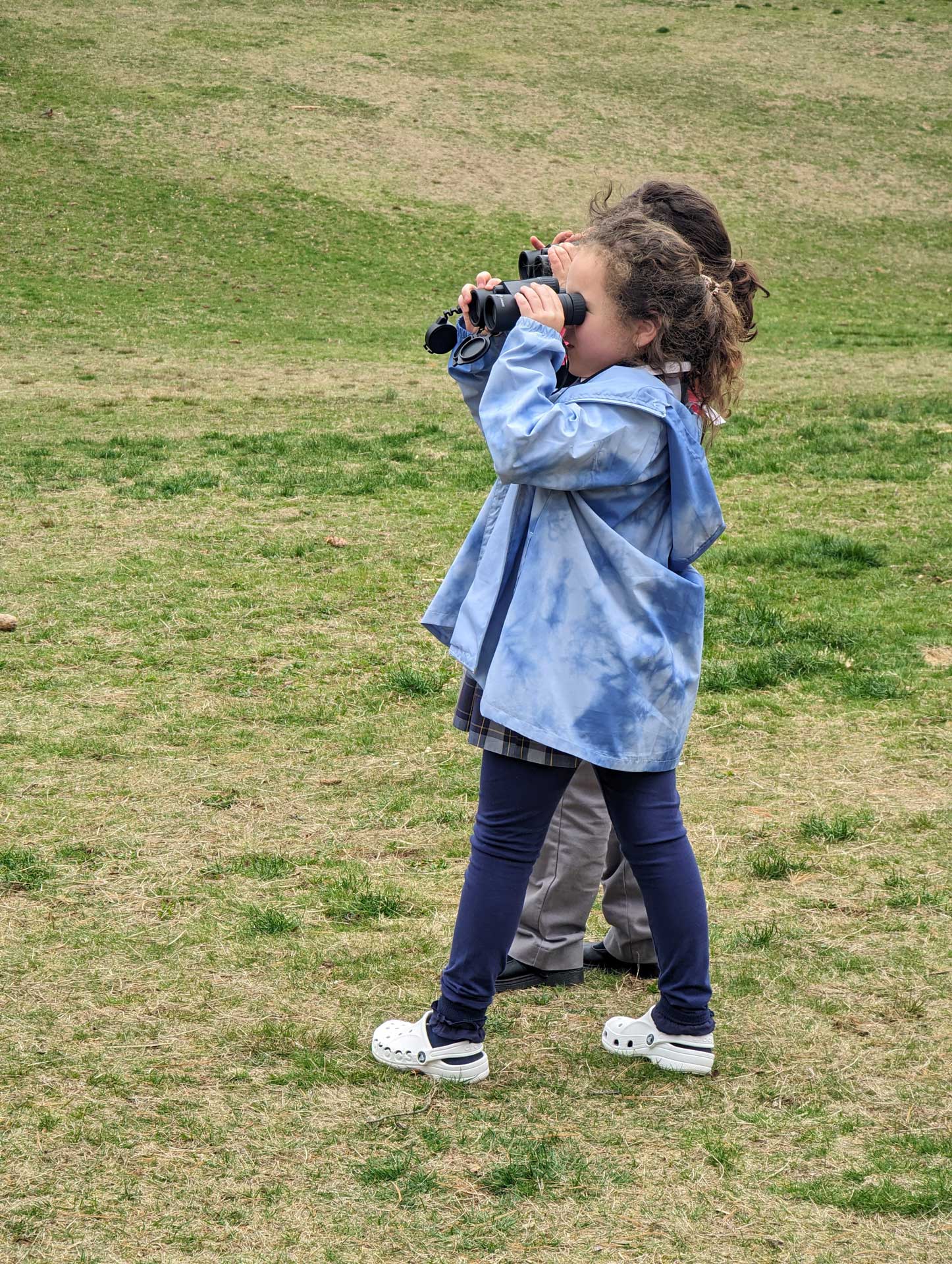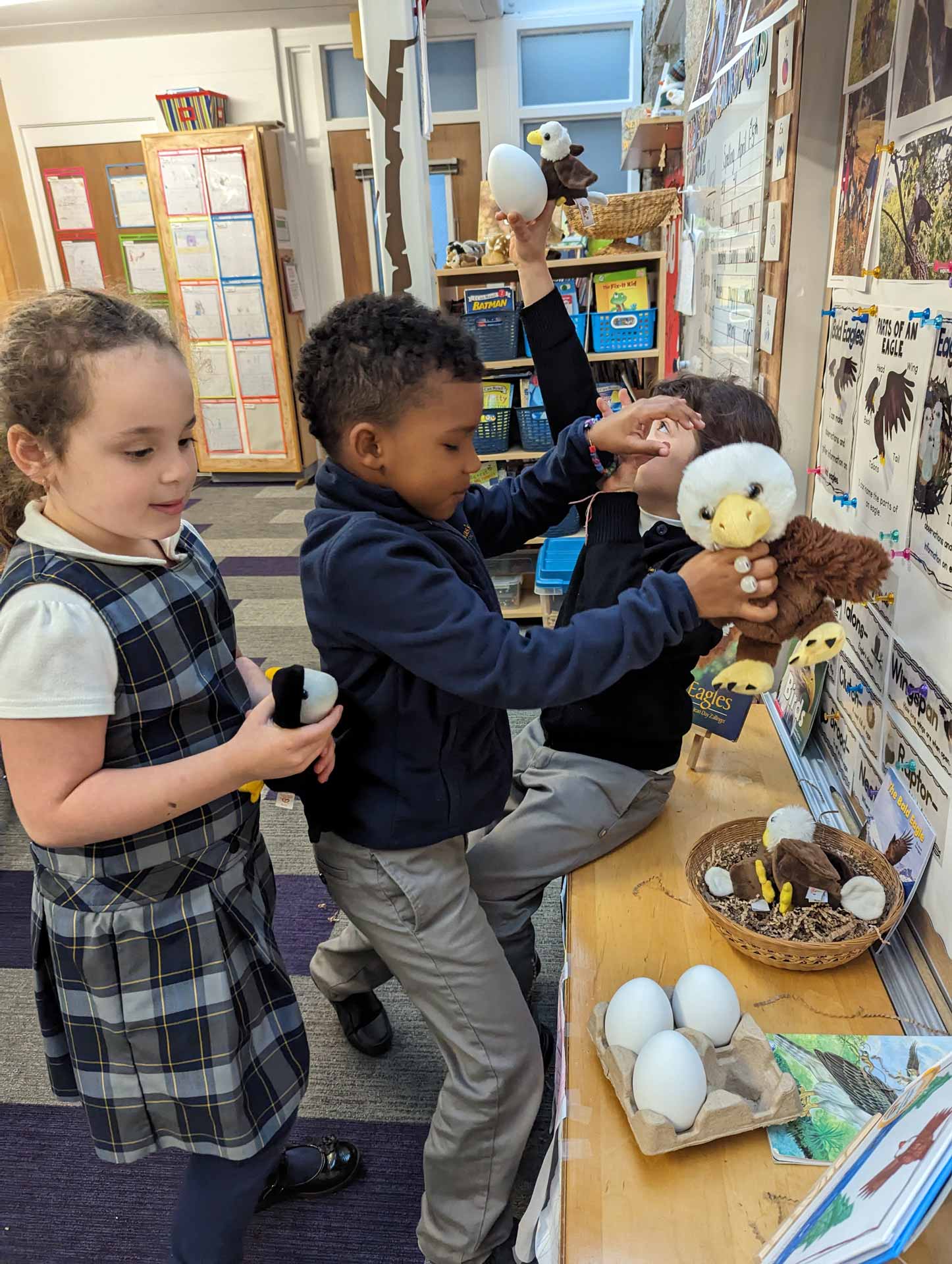Soaring Together: Building Community and Protecting the American Bald Eagle
For educators interested in place- based work, my advice is to let your students lead. Listen to them during play and in social conversations. Don’t doubt yourself- every project is unique, and each will have its own story and outcome. Don’t be afraid to put yourself out there and meet new people. So many community members are just looking for an opportunity to share their skills and knowledge. And, don’t be afraid to ask for help.
Myree Conway
First-Grade Teacher

Project Narrative
At the start of the school year, our social studies lesson centered around animal habitats, naturally leading us to nests. We talked about how eagle nests are enormous—far bigger than any they might spot in their backyard trees. Intrigued by this, we ventured outside, where I drew a 7-foot circle with chalk to demonstrate. I let the students decide how to explore this “giant” nest. One student wondered how many people could fit inside. We enthusiastically tried this out in our chalk nest. To our amazement, we found that a 7-foot circle could hold 16 children and 7 adults!
During our visit to Edgerton Park the next day, the students independently decided to construct their own giant nest and began collecting pine needles and other materials. Clearly their interest had only grown. Their curiosity shaped our learning, activities, projects, and community partnerships. I reached out to my friend Lori Carnes, a member of the Raptor Research Project in Iowa. With her guidance, my students made daily observations and journaled weekly about of a pair of American Bald Eagles. From mid-September to the end of the school year, we watched as the pair built a nest, laid eggs, incubated them, and welcomed their new hatchlings. We observed the eaglets mature from day one to week twelve, all the way to fledging the nest.
Throughout this period, I created an eagle learning center in the classroom with vocabulary, photos, stuffed eagles, books, and more. I integrated numerous cross-curricular lessons and activities that not only captivated the students but enriched their learning experience. A member from our local chapter of the Audubon Society directed us to two eagle nests located in New Haven, just minutes from our school. Mr. Carter visited the classroom with a bird scope and a set of binoculars for each student. He shared information about the eagles on State Street and eagles in general. Afterward, we took the students to Edgerton Park and taught them how to use the binoculars like true birders.
I wanted to find ways my students could raise awareness about the Bald Eagles on State Street and all the eagles across Connecticut. With this goal in mind, my students began creating a 3D model of State Street to be displayed in our school lobby. Their model was comprehensive, featuring detailed descriptions of the environment surrounding the nest itself, and the broader ecosystem. Additionally, they prepared a school wide presentation highlighting the significance of conserving and protecting these magnificent birds. Each student crafted a poster conveying a message about what we can do to protect the bald eagle. They also spoke passionately about the bald eagle, engaging in a short Q & A session with the whole student body. It was truly inspiring to witness first graders’ fervent dedication to the eagles and their enthusiasm for learning shine through as they shared their knowledge with others.


Measuring Impact
Assessing student learning outcomes, standards met, skills developed, and community impact.
LEARNING OUTCOMES
Research Skills Development
Deepened Understanding of Ecosystems Students saw first-hand the role of specific species within them.
Insights into Conservation Efforts and Challenges
Communication Skills Crafting and delivering the presentation demonstrated public speaking, storytelling, and visual presentation abilities.
Collaboration Working with peers and engaging with the school community fostered teamwork and leadership, and a sense of responsibility towards environmental stewardship.
Curiosity Students consistently asked questions and talked about the eaglets and eagles, extending learning and broadening connections.
Empowered Students to advocate for positive changes in their community.
Meeting Standards and Developing Learners
- Record observations in journals with drawings and personal reflections.
- New vocabulary through word cards with photo and definition to use in sentence/story writing.
- Read stories and poems on eagles.
- Write sentences, short story or poems.
- Share information in a short presentation with peers.
- Collaborate on a non-fiction story for classroom book publication.
- Write persuasive letters promoting eagle conservation.
- Observe how eagles build/prepare the nest: what materials they use, how long it takes, etc.
- Explore park across the street from the school to build their understanding about landscapes/ecosystem through first-hand experiences.
- Observe local eagles and eagle nest on a field trip, utilizing mapping skills, journaling, etc.
- Build a nest using materials gathered in nature.
- Identify the basic physical characteristics of the eagle based off of pictures, slides, books, and diagrams and explain how these features help eagles thrive, how they adapt. See Labeling Slides in downloads section.
- Develop understanding of the eagles’ role in their environment (top predator) and in the food chain/food web.
- Demonstrate understanding of food chain and how energy flows from plants to prey to predators and the importance of maintaining a balanced ecosystem.
- Understand how eagles hunt.
- Describe the eagle’s impact on the food chain
- Identify the life cycle of the eagle from egg to full grown eagle (ie egg, hatchling, fledgling, and adult) and be able to distinguish between the various stages. See Eagle Life Cycle in downloads section.
- Observe and identify the eagle’s nesting process (the laying of eggs, brooding, and hatching/caring of young eaglet) through pictures, literature, and live video feed
- Label parts of the nest, eagle, and eaglet.
- Explore the historical cultural significance of eagles in different cultures and societies. See link to “The Trio” podcast below.
- Understand the eagle’s symbolism.
- Investigate the threats facing eagle populations such as habitat loss, pollution, natural disasters, etc.
- Learn about current conservation efforts through visits from the Audubon Society, video conferences from Decorah Raptor Project, and other
resources. - Propose solutions for protecting eagles and their habitats.
- Propose solutions for bringing attention to eagles to their community
- Create addition and subtraction problems utilizing knowledge of eagles. See Making Ten Math Slides.
- Make predictions regarding the time frame of eagles laying egg(s) and chart them.
- Introduction to circle measurements and circumference through drawing and demonstrating the size of an eagle’s nest.
- Practice non-standardized measuring comparing eagle egg to other bird/animal eggs.
- Understand weight of egg through non standardized measures and chart measures.
- Use the wingspan of the eagle to measure their own wingspan.
- Create informational posters to bring awareness to the conservation of eagles.
- Create a sculpture of an eagle or a nest using clay, playdoh, etc.
- Use recycled materials to create 3D map.
- Design an eagle mask and decorate to resemble eagles, adding feathers, paint, etc.
- Construct eagle wings using felt, elastic, and fabric glue. Download eagle color/cut sheets in the next section.
- Listen to songs that focus on themes such as flight, freedom, and nature (ex: Fly Like an Eagle by Steve Miller Band).
- Explore instruments to determine what instrument(s) might mimic the sounds of eagle or the natural environment.
- Use instruments to add sound effects to connected literature.
- Engage in movement activities to create dances or movements inspired.
- Understand how cameras are installed (through video demonstration) for eagle observation.
- Use digital software such as Wixie to create a story on eagles (fiction or nonfiction).
- Observe a live video feed of eagles nest in Decorah, Iowa Eagle Cam.
- Listen to natural sounds of eagles using various teacher-approved sights.
- View an eagle in flight through VR headset and document how it made them feel.
- Connecting Literature to Technology, create a 3D prosthetic beak. See “Beauty and the Beak” download.
Links and Downloadable Materials
-
Flying Eagle Cut/Color Sheet
Students used this printout to create eagle wings using felt, elastic, and fabric glue.
-
Making Ten: Math Slides
Addition and counting from the Raptor Project
-
Podcast
The Trio: A Bald Eagle Family Tale
From PBS LearningMedia for Teachers: "The story puzzles scientists, reinforces indigenous wisdom, and wows audiences, all thanks to a park ranger named Ed and a well-placed webcam." -
Beauty and the Beak
This educational guide by Deborah Lee Rose and Jane Veltkamp tells the story of how a 3D-printed beak saved a bald eagle.
-
Decorah North Bald Eagle Cam
The Raptor Resource Project's Eagle Cam that Myree's students used throughout their bald eagle study.
-
Raptor Resource Project Teachables
The Raptor Resource Project is a non-profit organization that educates people around the world about raptors and their habitats. They have a robust library of teacher-created lessons, crafts, and activities.
-
Mrs. Conway’s First Grade Eagle Information Slides
This slideshow contains a wealth of information. photos and links related to Myree's first-grade classroom study on eagles.
-
Bald Eagle Vocabulary
Slides are divided into nouns and verbs so students can learn about parts of speech while they studied eagles.
-
My Bald Eagle ABC Book
A downloadable, made-for-printing PDF with space for student drawings and writing.
Resources
- Books
- Community Partners
- Materials
The Eagle Feather by Kevin Locke
The Eagles are Back by Jean Craighead George
The Bald Eagles of Money Bayou by Valerie Seyforth Clayton
On Eagle’s Cove by Jane Yolen
Fly Eagle Fly: An African Tale by Christopher Gregorowski
Bird, Butterfly, Eel by James Prosek
A Nest is Noisy by Diana Hutts Aston
Beauty and the Beak by Deborah Lee Rose
Esther the Eaglet by Christine Gove-Berg
Baby Eagles by Jenna Grodzicki
The Eagle and the Sausage Dog by A. J. Larcombe
Bird Nests: Amazingly Ingenious and Intricate by Stan Tekiela
Bald Eagles (Wild Life LOL) by Scholastic
Eagle in the Sky: An Interactive Adventure about the Bald Eagle by Ryan Jacobson
New Haven Audubon Society board members (Gilles Carter and Von Porter)
https://ct.audubon.org
Glen Cummings NH Bird Club member
Michelle ’Keefe – New Haven Birder
Lori Carnes- Decorah Eagle Project (Decorah, Iowa) Raptor Resource
Christine’s Critters Raptor Rehab Center, Fairfield, CT (Christine Peyreigne)
https://www.christinescritters.org
Josiah Venter, St. Thomas’s Day School Outdoor Classroom/Science Teacher
Institute for American Indian Studies Museum (Darlene Kascak)
dkascak@iaismuseum.org
DEEP (Brian Hess)
deep.webmaster@ct.gov
State Street Eagles Facebook page (Mike Horn- Volunteer for CT DEEP)
Angelo Rosetti (photographer and Eagle Enthusiast- State Street Eagles)
Possible Futures Book Store
https://www.possiblefuturesbooks.com
Eli Whitney Museum (binoculars)
- Class set (15) of binoculars (generously lent by Eli Whitney Museum)
- Scope for observing eagles and nest from safe distance
- Books
- Learning Center materials:
- plastic egg,
- nesting materials,
- stuffed animals,
- coloring pages,
- writing materials
- student journals
- Wings craft:
- Felt,
- Elastic,
- Masks,
- Fabric glue
- Live feed from Raptor Resource Center






